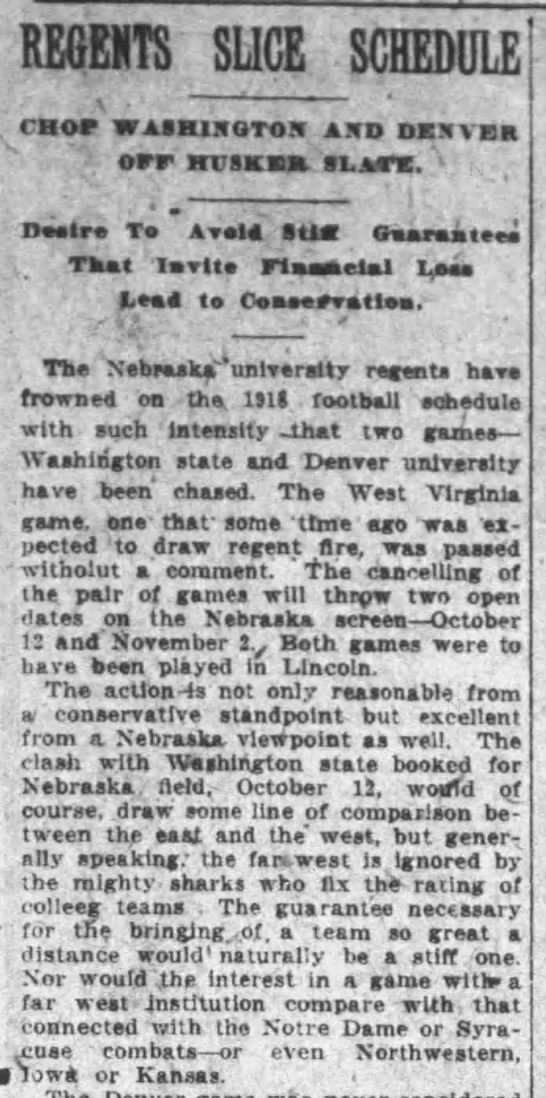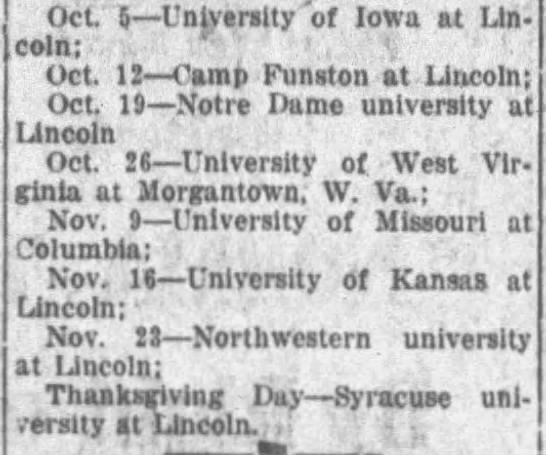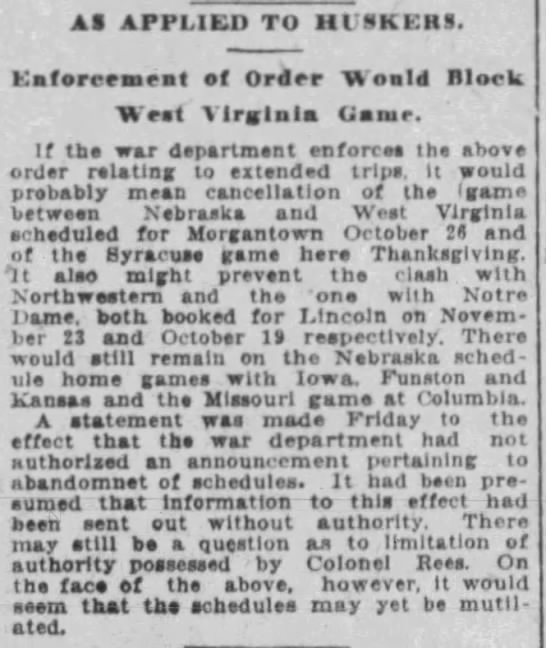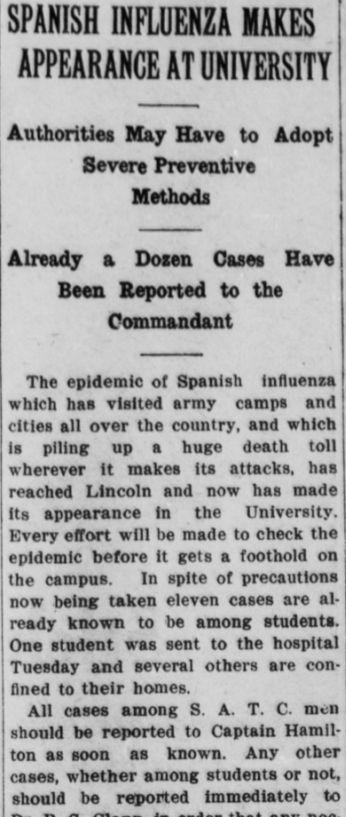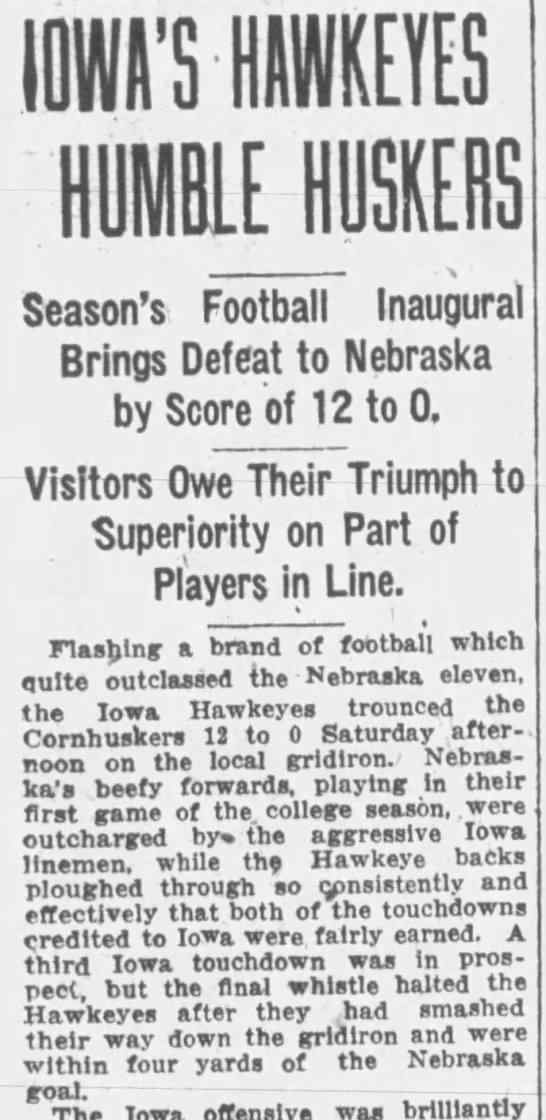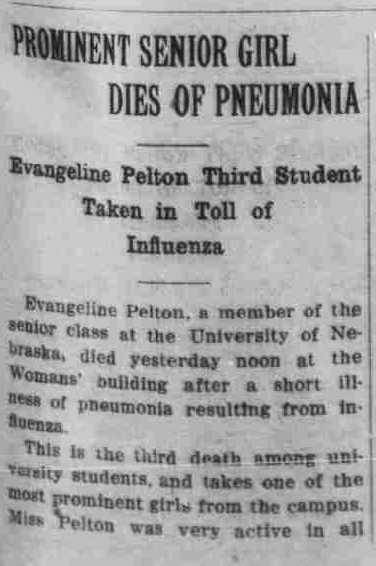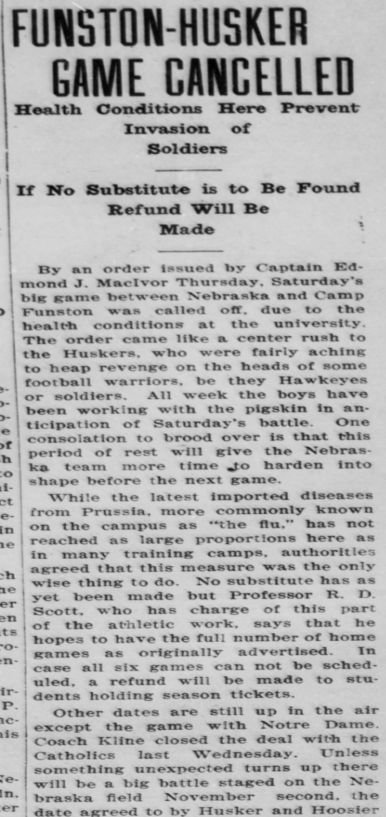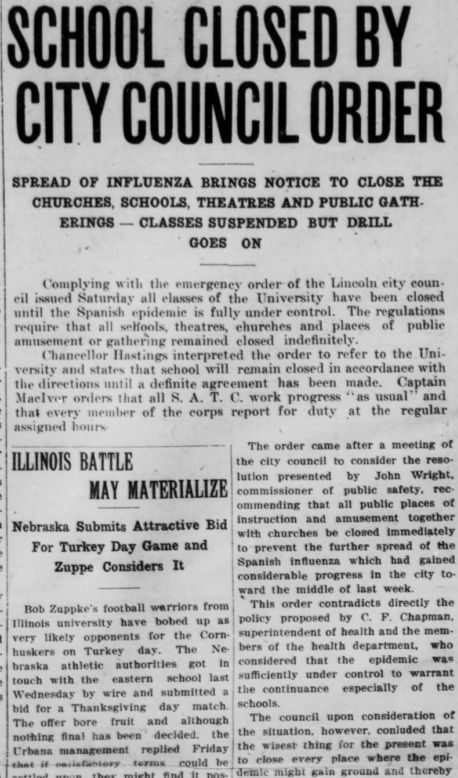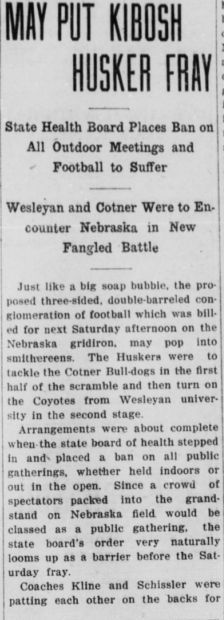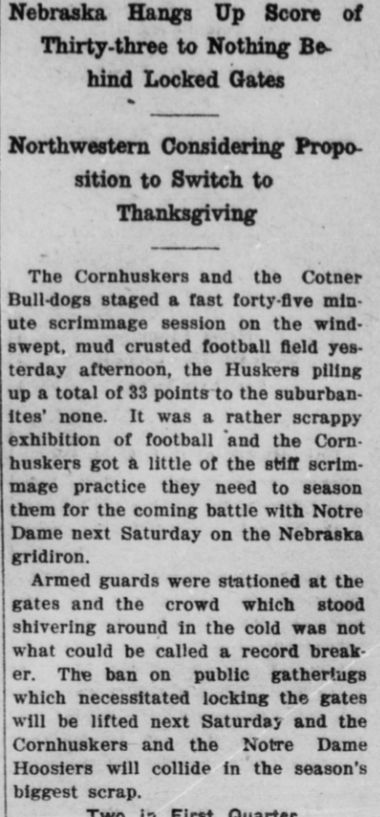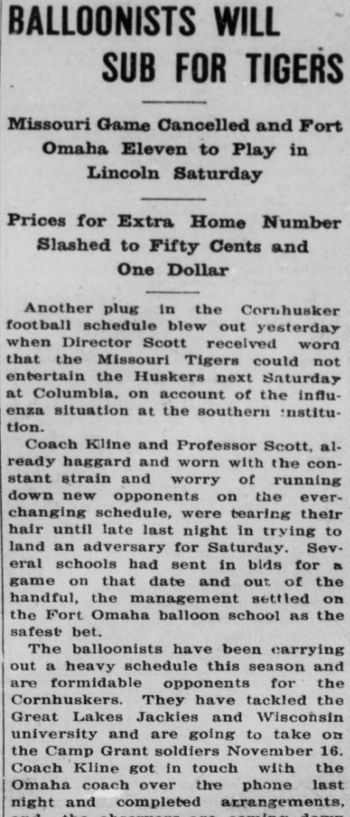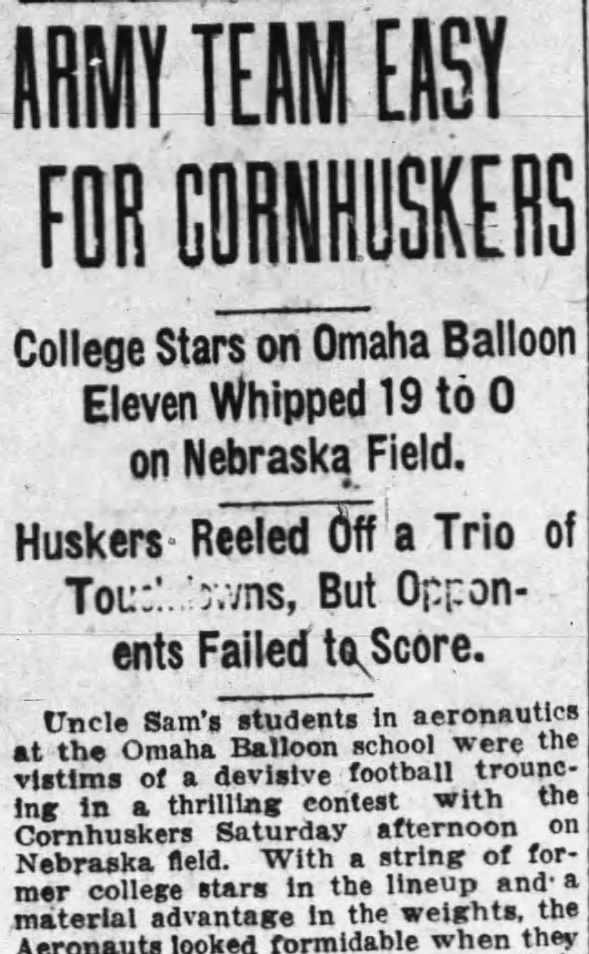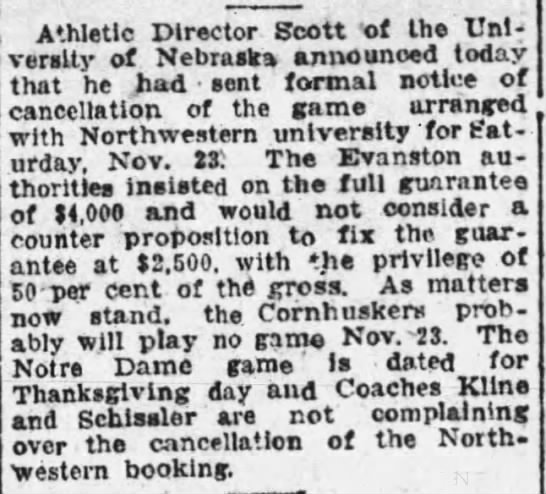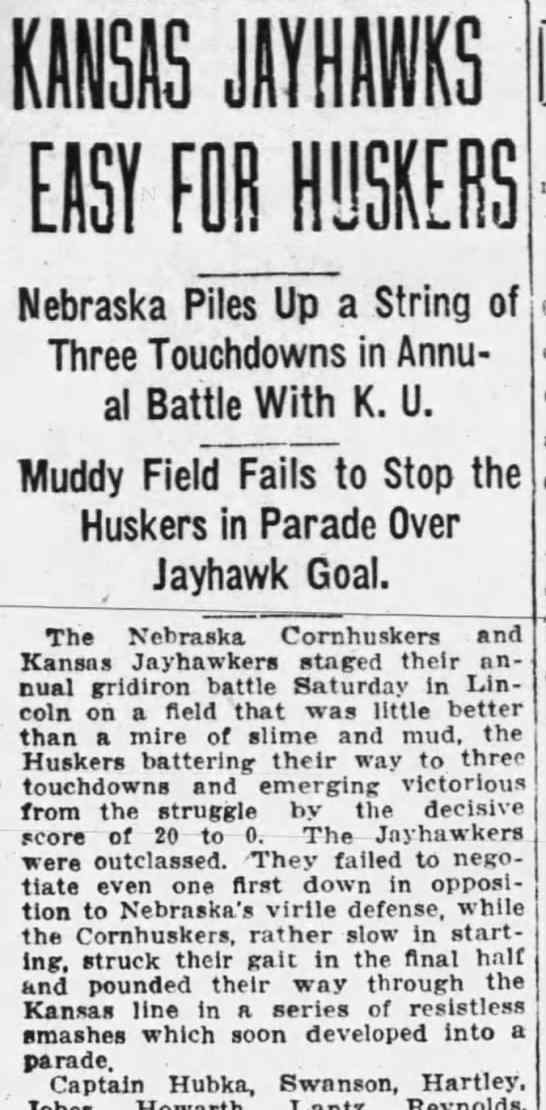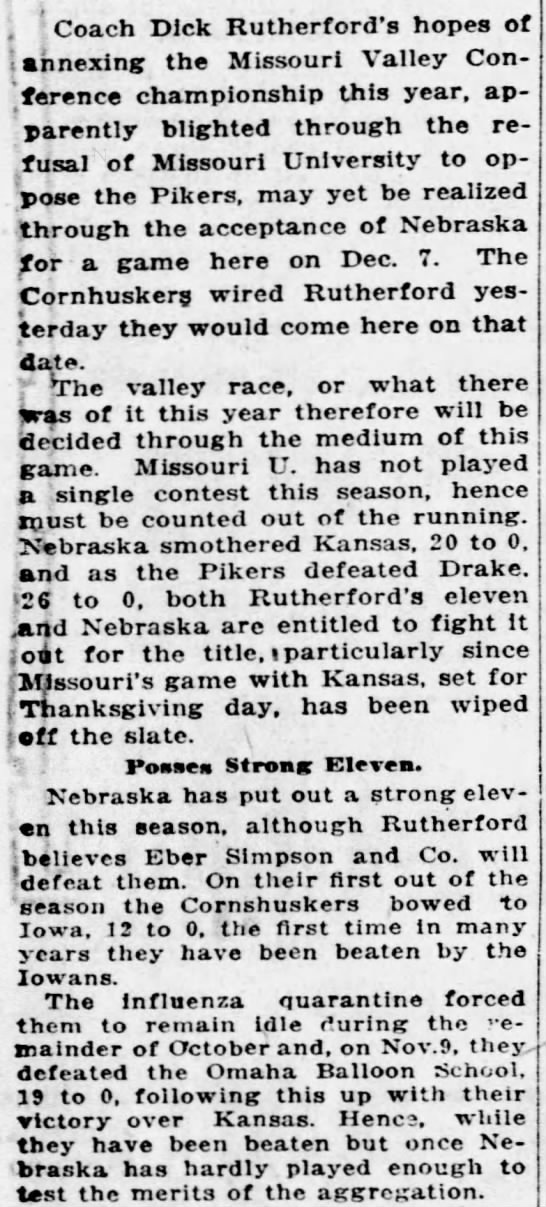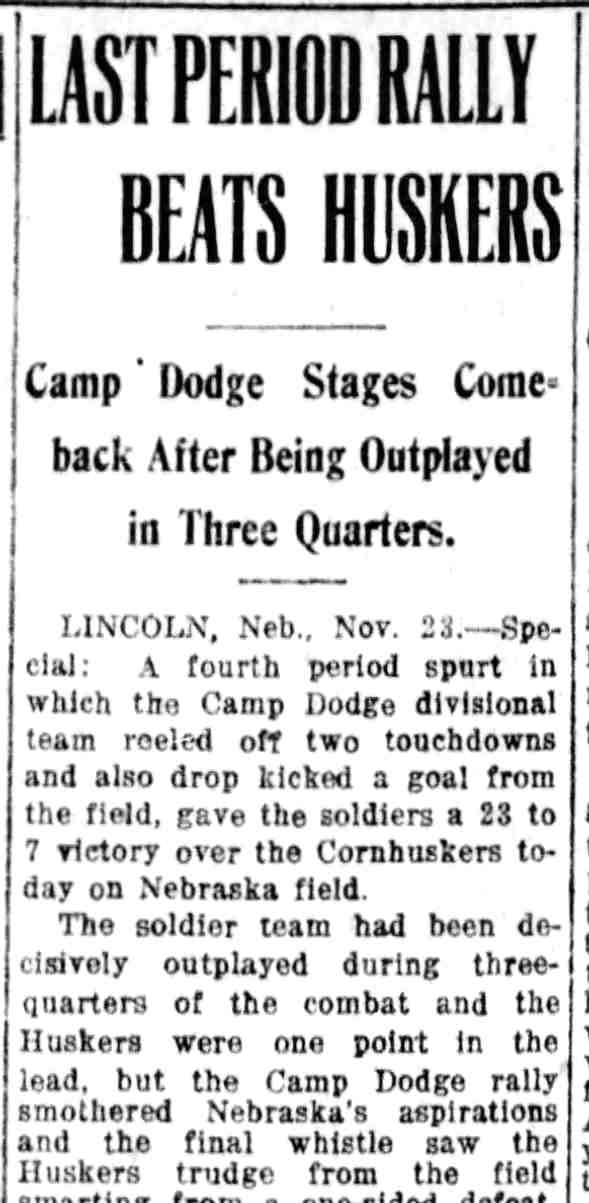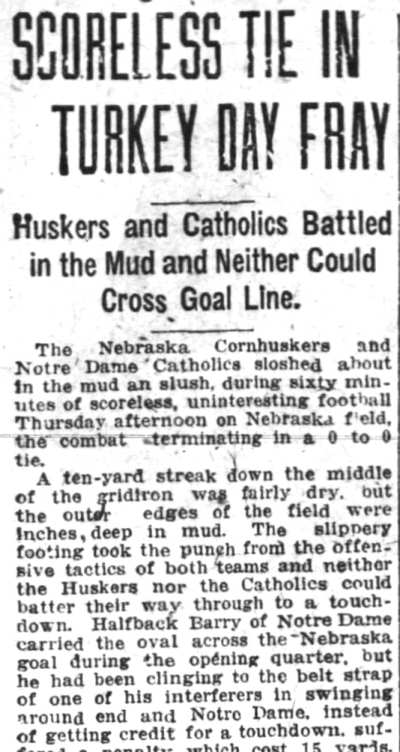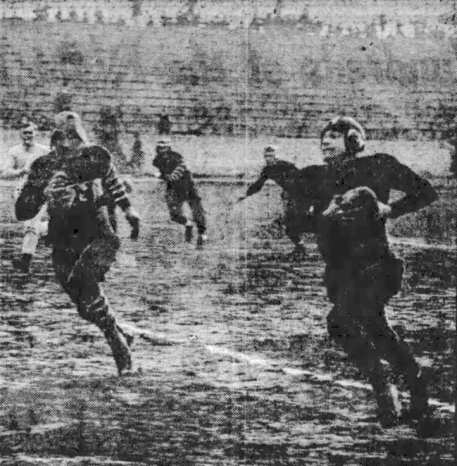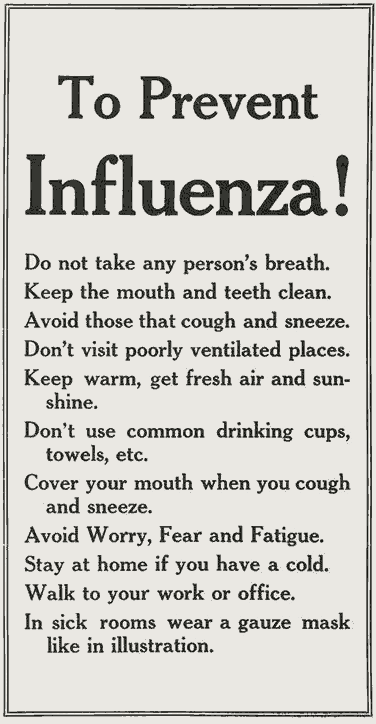1918: War, influenza and football
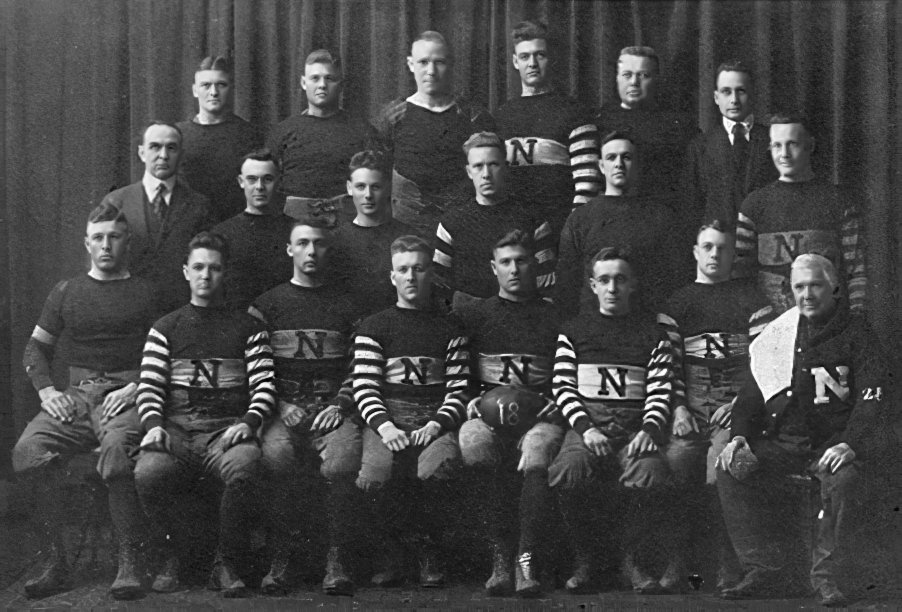
 A timeline of the 1918 Nebraska Cornhuskers’ season and the challenges caused by war and pandemic. • Back: Cypreanson, Hoyt, Dana, M. Munn, Ross, Schissler. Running a college football program during a major war is a challenge enough. Calls to military duty send rosters into constant flux. Sports tend to slip several notches down society’s list of priorities. Toss in the horrific Spanish flu pandemic and it’s a wonder any games were played at all in 1918. The 1918 Nebraska schedule originally consisted of this 10-game lineup. In a season of ever-changing circumstances and at least a dozen schedule adjustments, only two games would be played as originally billed. A third would happen only after twice being postponed. 09/28 Camp Funston 10/05 Iowa 10/12 Washington St. 10/19 Notre Dame 10/26 @West Virginia 11/02 Denver 11/09 @Missouri 11/16 Kansas 11/23 Northwestern 11/28 Syracuse It’s safe to say coach William G. Kline and athletic director R.D. Scott more than earned their pay in 1918. What follows is a timeline of how the Huskers ultimately managed to play six games under the unprecedented conditions of the time. June 14: Two home games scrubbedNebraska’s regents decide the payments to Washington State and Denver for traveling to Lincoln would place unnecessary strain on the budget during a time of less-than-robust ticket demand, so those games are canceled. Perhaps replacements can be found, but for now the original 10-game schedule is down to eight. Aug. 24: Holes to fill as of late summerTwo months later, the only change from mid-June is that the late-September game against Camp Funston has been moved to Oct. 12, occupying the spot formerly held by the Washington State game. It remains an eight-game slate for the Cornhuskers. Sept. 15: Wartime travel limitsWith the military calling the shots, Nebraska and other schools with Student Army Training Corps programs are forbidden to take extended trips for football. That means no game at West Virginia in October and no Syracuse game in Lincoln on Thanksgiving. It could have been worse, as it was initially feared football would be canceled outright. Still, the schedule is now a mere six games, and filling the Thanksgiving slot becomes a top priority. A welcome byproduct of the intertwining of football and the military: freshman eligibility. Oct. 1: Influenza hits LincolnSpanish influenza swept into the state in late September and is now officially a concern in Lincoln. But it’s not enough of a worry to call off the Oct. 5 season opener against Iowa. The Daily Nebraskan contains a number of precautions to follow, such as avoiding “crowded street cars, rooms, etc.” Even so, students “packed the Temple theatre to the rafters” for a pep rally later in the week. Oct. 5: The Iowa gameThe season opens with a 12-0 home loss to Iowa, winners for the first time in the series since 1899. An estimated 10 pounds per man lighter, the Iowans exploit the Huskers on the ground and via the air as a smaller crowd than expected looks on. It is the final game for two starters, right halfback Harold McMahon and left tackle Al Duteau, who are called to service in the Navy. Oct. 7: Death comes to campusOn the Monday after the Iowa game, the university’s first flu-related fatality is reported in the Daily Nebraskan. The death of John J. Knoll was technically caused by pneumonia, as was common in influenza cases. By the end of the week, at least five more fatal university cases would be reported. Oct. 8: Notre Dame game postponedA new War Department directive further restricts schools’ scheduling options, derailing the Oct. 19 home game with Notre Dame. The government order essentially limits Nebraska’s October opponents to teams from nearby military training units. Games with more traditional opponents will have to wait until November. Nebraska and Notre Dame quickly reschedule their game for Nov. 2, the slot originally occupied by Denver. Oct. 10: Camp Funston game canceledIn the Huskers’ first flu-related game cancellation, the Oct. 12 contest with the Camp Funston team from Fort Riley, Kan., is called off two days before it was to happen. The citywide death toll is now approaching 30. Athletic director Scott says he still hopes to have six home games when all is said and done. (Oddly enough, Camp Funston is where the “Spanish” flu is believed to have originated in early 1918.) Oct. 12: University closedThe university heeds a Lincoln City Council order that all schools, theaters, churches and places of public amusement or gathering be closed indefinitely. The 1,700-member Student Army Training Corps, which includes the football players, is not affected, however. Meanwhile, the university unsuccessfully pursues Illinois as a possible Thanksgiving opponent. Oct. 22: No scrimmage for you!Hoping to tune up for the Nov. 2 Notre Dame game, the Huskers schedule a three-way public scrimmage at Nebraska Field for Saturday, Oct. 26, with Cotner College and Nebraska Wesleyan. But a widening of state flu restrictions to include outdoor gatherings puts an end to those plans. (It’s unclear from news articles why a no-fans scrimmage wasn’t held instead.) The citywide death toll is now above 90. Oct. 29: A scrimmage, but fans barredWith armed guards stationed at the Nebraska Field gates to enforce the ban on public gatherings, the Huskers trample Cotner College in a Tuesday afternoon scrimmage, 33-0. The Notre Dame game is now just four days away, and the ban is expected to be lifted by then. Meanwhile, hopes of landing the Great Lakes Navy Bluejackets as a Thanksgiving opponent don’t pan out. (The “Jackies,” with George Halas starring, would win the 1919 Rose Bowl.) Oct. 31: Notre Dame game is off againLess than 48 hours before kickoff, the Nov. 2 Notre Dame game is called off after the city council opts not to lift restrictions on public gatherings. The South Bend school quickly agrees to reschedule the game for Thanksgiving, solving an issue that had vexed Nebraska management since mid-September. Nov. 6: Trip to Missouri canceledIn the last few days, the university has reopened and Lincoln has lifted its ban, but the improvement on the health front isn’t happening everywhere, particularly in Columbia, Mo. Three days before kickoff, the Nebraska-Mizzou game is canceled, but the vacancy is quickly filled with a home date against the Omaha Balloon military team from Fort Omaha. The Huskers tune up for the game by scrimmaging with Nebraska Wesleyan for the second time in as many weeks. Nov. 9: After five weeks, an actual gameThe Omaha Balloon team is sprinkled with university-caliber talent but falls to the Huskers, 19-0, without gaining so much as a first down. The visiting delegation spices up the day in Lincoln with a parading brass band, a balloon and airplane flying overhead, and a young black bear mascot. It’s the last 1918 game for Elmer Schellenberg, who decides to enter officers training school. Nov. 13: No more war, and no WildcatsTwo days after an armistice ends World War I hostilities, Nebraska cancels its Nov. 23 home game with Northwestern. Nebraska for weeks had tried to renegotiate Northwestern’s $4,000 guarantee, which became less and less affordable as the season unraveled. The Des Moines-area Camp Dodge military team agrees to fill the Nov. 23 slot. Nov. 16: A shutout of KansasNebraska dominates the second half, turning a slim 2-0 lead into a 20-0 win over Kansas on a field of “slimy, black ooze” in Lincoln. Clarence Swanson scores two of the Huskers’ three touchdowns, and Nebraska makes it two games in a row without surrendering a first down. In the stands, it’s a substandard Homecoming turnout because of the poor conditions. Reported flu deaths in the city are now down to about two per day, less than half the October rate. Nov. 22: December football on tapNebraska and Washington of Missouri, a fellow Missouri Valley Conference school, agree to a Dec. 7 postseason game in St. Louis. This would turn out to be the last of the many schedule adjustments for 1918, though talk of a second December game, perhaps with Kansas State, would continue to percolate. Nov. 23: Stunned by Camp DodgeSquandering opportunities left and right, the Huskers dominate the first 45 minutes but have only a 7-6 scoreboard advantage to show for it entering the fourth quarter. The Iowa military squad makes Nebraska pay, exploding for 17 points in the final period for a 23-7 win. Nov. 27: News of Roscoe Rhodes’ deathAs the team gears up to face Notre Dame, Nebraska gets good news — and then the worst sort of news. All-conference halfback Paul Dobson, newly discharged from Navy training in Massachusetts, is returning to the team just in time for the big game. But then comes word that Roscoe Rhodes, Nebraska’s captain-elect before being drafted in April, was killed in action in France in late October. His sacrifice, and that of so many other Nebraskans, would become the inspiration behind the naming of Memorial Stadium. Nov. 28: A tie with Notre DameAfter two postponements and much anticipation, the big game finally arrives. On a muddy field and in front of a smaller-than-expected crowd, Nebraska and Notre Dame battle to a 0-0 draw. The visitors outyard the Huskers by a wide margin, but Paul Dobson’s stellar punting helps keep Notre Dame out of the end zone. The Lincoln Star describes it as “sixty minutes of scoreless, uninteresting football.” Dec. 7: Setback in St. LouisNebraska ends the season on a down note in St. Louis, absorbing a 20-7 defeat to Washington University of Missouri. The Cornhuskers score first, on a 15-yard pass from Paul Dobson to “Link” Lyman, but are shut out the rest of the way. The Huskers played the game despite some grumbling about the questionable eligibility of several key players for Washington, a team coached by former Nebraska captain John Rutherford. Wins, losses and mortalityThough Nebraska’s final record of 2-3-1 was unspectacular, the team’s perseverance though grim circumstances stands out. By the end of the year, Lincoln’s official tally of flu deaths had reached 265, more than half occurring in the brutal month of October. By mid-1919, the state’s death toll was reported to be anywhere from 2,800 to 7,500. Globally, the great war killed 15 million to 19 million people, including 751 Nebraskans. The flu pandemic is believed to have taken 50 million to 100 million lives. |
